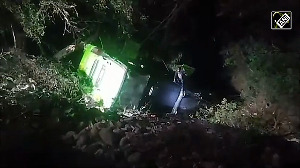The lack of security and poor intelligence has allowed terrorists to trigger several blasts in other parts of India too.
Though no known outfit claimed responsibility for the Jaipur attack, a hitherto unknown Islamic militant group by the name Indian Mujahideen declared through an e-mail that the attack was carried out to dismantle the tourism sector in Rajasthan and to contest moderate Muslims who did not support the jihadi movement in India.
It also disclosed that the group was responsible for the blasts on November 23, 2007 in Uttar Pradesh. However, the needle of suspicion pointed towards the Bangladesh-based Harkat-ul-Jihadi-e-Islami along with the Student Islamic Movement of India. The modus operandi clearly suggested the involvement of these two outfits that were earlier involved in similar serial blasts in Malegaon on September 8, 2006 and the UP blasts.
Claming responsibility of an attack by an unknown or a fake group has become a tactic for many terrorist groups operating in India. It helps them to confuse the security establishment. After the July 7, 2006 attacks in Mumbai, a claim was made through an e-mail by a new group with links to the Pakistan-based Lashkar-e-Tayiba called the Lashkar-e-Qahar.
Similarly, after the October 29, 2005 Delhi serial blasts, a hitherto unknown outfit, Inquilabi (Revolutionary) Group claimed responsibility for the attack and warned of more such attacks.
Likewise, the Varanasi terrorist attack on January 7, 2006 was claimed by a fictitious group called the Lashkar-e-Qaharby.
Recent trends indicate that attacks by terrorist groups are no more limited to combatants and government structures. Their current strategies include impeding India's economy by attacking tourism sanctuaries, information technology sectors and railway and aviation industries. It is noteworthy that Rajasthan is among the top five destination states in India for both domestic and foreign tourists. The tourism sector contributed 15 per cent to the state economy.
Apart from attacking tourism, the attack against Hindu temples pointed to the fact that targets were Hindu devotees. In fact, the blasts were carried out to ignite communal apprehensions in the country. Over the past few years, terrorists have been attacking mosques and temples in places like Ajmer (October 11, 2007), Ayodhya (July 5, 2005); Hyderabad (May 18, 2007); Malegaon (September 8, 2006); New Delhi (April 14, 2006) and Varanasi (March 7, 2006). However, despite their repeated attempts, communal riots did not break out in the country. There is certainly a growing public awareness about the terrorist strategy. Interestingly, all these attacks happened on Tuesdays (at temples) and Fridays (at mosques), religious days for both Hindus and Muslims.
Terrorist groups have been choosing relatively peaceful states where the element of surprise works better. Rajasthan Chief Minister Vasundhara Raje revealed that she had never expected such a massive strike and hence the security apparatus was not prepared. The argument does not hold ground in view of the Ajmer incident and the warning in a Hindi weekly newspaper Iman Ki Awaaz published from Mominpura in Nagpur about a possible major attack in Jaipur.
Similar was the case in Andhra Pradesh. Security was not strengthened in Hyderabad after the Mecca Masjid blasts (May 18, 2008), and hence three months later, on August 25, another pair of coordinated attacks rocked the city at Lumbini Park and Gokul Chaat (Kothi).
It may be a first terror attack in Jaipur or the second in Rajasthan after the Ajmer attack, but it is not new in India. Over the past many years, with such unusual and highly improvised strikes, a new form of terror has arrived in India. It can be termed as 'hinterland terrorism', or terrorism in heartland.
Most blast cases still remain unsolved. The poor handling of such sensitive issues provide opportunities to terrorists to enter and operate in many states. With their extremely intricate networks, their presence in fact, is growing in various parts of the country. They now have the capability to trigger blasts at will. Terror targets cannot be protected by machines or manual security programmes alone. However, they can be countered to a great extent by enhancing cooperation among security agencies and timely intelligence sharing; strengthening political will; and most importantly public support.
Thangjam Khurshchev Singh is a researcher at the Institute for Defence Studies and Analyses, New Delhi






 © 2025
© 2025